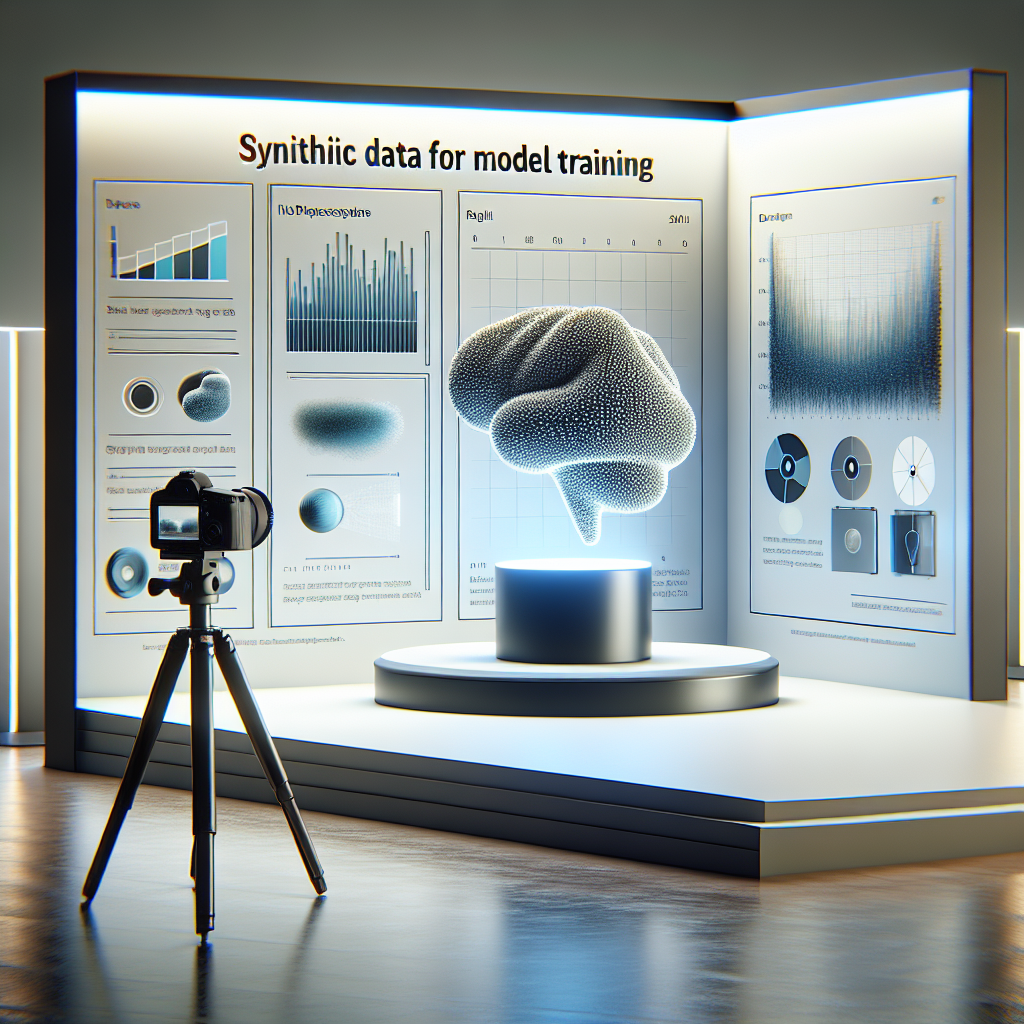Unlocking the Future: How Synthetic Data is Revolutionizing Model Training
Table of Contents
- Introduction
- What is Synthetic Data?
- The Importance of Synthetic Data in Model Training
- Real-World Examples of Synthetic Data
- Benefits of Using Synthetic Data for Model Training
- Challenges and Limitations of Synthetic Data
- How to Generate Synthetic Data
- Best Practices for Using Synthetic Data
- The Future of Synthetic Data in AI and Machine Learning
- Conclusion
Introduction
Let’s face it: in the fast-paced world of artificial intelligence (AI) and machine learning (ML), having top-notch data is everything. But here’s the catch—traditional datasets come with a host of challenges like privacy issues, data shortages, and biases that can skew results. That’s where synthetic data swoops in like a superhero! Imagine a scenario where you can generate data on the fly, tailor it to your specific needs, and sidestep all those pesky privacy concerns. Sounds pretty great, right? Well, that’s the reality we’re stepping into with synthetic data.
According to a report from the Statista Research Department, the growth of synthetic data generation is set to skyrocket in the coming years as industries begin to realize just how much it can boost model training. In this guide, we’re going to dive deep into what synthetic data is all about, why it’s so crucial for model training, some real-world examples, its benefits, challenges, generation techniques, best practices, and what the future holds. Whether you’re a seasoned data scientist, a business leader, or just someone curious about AI, there’s something here for you!
What is Synthetic Data?
Synthetic data is basically information that’s artificially created to mimic the characteristics of real-world data. It’s generated through algorithms and models instead of being collected from actual events or transactions. You can find synthetic data in various forms, including images, text, and numerical data, making it super versatile for a bunch of different applications.
1. Types of Synthetic Data
- Images: Think about how generated images can be a game changer for training computer vision models. For example, GANs (Generative Adversarial Networks) can create incredibly realistic faces, objects, or even stunning landscapes.
- Text: For natural language processing (NLP) tasks, we can train models on synthetic text data—this could range from user interactions to full-blown conversations and articles.
- Numerical Data: In fields like finance, synthetic numerical datasets can simulate real-world scenarios, which is vital for predictive analytics.
2. Comparison with Real Data
Now, let’s talk about the differences between real data and synthetic data. Real data can be messy and inconsistent, not to mention often limited in quantity. Synthetic data, on the other hand, can be produced in large volumes, giving models plenty to learn from. Plus, you can tweak it to reduce biases found in real datasets, creating a more balanced training environment.
The Importance of Synthetic Data in Model Training
You might be wondering why synthetic data is such a big deal for model training. Well, it tackles a lot of the challenges that data scientists and ML experts commonly face.
1. Overcoming Data Scarcity
In areas like healthcare, finance, and autonomous vehicles, gathering large datasets can feel like searching for a needle in a haystack. Synthetic data steps in to bridge those gaps, providing the essential training data without the hassle of extensive data collection.
2. Enhancing Privacy and Compliance
With all the buzz around data privacy regulations, synthetic data is a compliant alternative. Since it doesn’t include personally identifiable information (PII), organizations can use it confidently without worrying about privacy law violations.
3. Reducing Bias in Training
Let’s face it: real-world datasets often carry historical biases. By using synthetic data, researchers can create a more equitable representation of various groups, leading to models that are fairer and ultimately more accurate.
Real-World Examples of Synthetic Data
To truly grasp the impact of synthetic data, let’s look at some real-world applications where it has made a noticeable difference.
1. Autonomous Vehicles
Companies like Waymo and Tesla heavily lean on synthetic data to train their self-driving algorithms. By crafting simulated environments, they can generate millions of driving scenarios, including those rare, risky situations that are tough to capture in real life.
2. Healthcare
In the healthcare sector, organizations such as Akamai have harnessed synthetic data to build patient models for predictive analytics. This way, researchers can analyze patient outcomes while keeping actual patient data private and compliant with regulations.
3. Financial Services
Financial institutions are on board too, using synthetic data to simulate a variety of market conditions. For example, JPMorgan Chase employs synthetic datasets to test their algorithms against a range of economic scenarios, which is vital for solid risk management.
Benefits of Using Synthetic Data for Model Training
Beyond addressing challenges, synthetic data brings a whole host of benefits that make it a compelling option for model training.
1. Cost-Effectiveness
Let’s be real—generating synthetic data can save a lot of money compared to collecting and cleaning real-world datasets. This cost efficiency is especially valuable for startups and smaller organizations that might be working with tighter budgets.
2. Scalability
Since synthetic data can be churned out in large batches, scaling up training efforts becomes a breeze. This scalability allows models to be trained more swiftly and effectively.
3. Flexibility and Customization
Another huge perk? Researchers can tailor synthetic datasets to meet specific model needs. This flexibility ensures that models are trained on data that accurately reflects the scenarios they’ll face in the real world.
Challenges and Limitations of Synthetic Data
Of course, while synthetic data has its fair share of advantages, it’s important to recognize some challenges as well.
1. Quality Concerns
The quality of synthetic data is a big deal. If the generated data doesn’t mirror real-world conditions accurately, it can lead to models that perform poorly. So, ensuring the authenticity of synthetic data is vital.
2. Complexity of Generation
Generating synthetic data isn’t always a walk in the park—it can be complex and often requires a solid understanding of data science and AI. Organizations may need to invest in specialized tools and skilled personnel to create high-quality synthetic datasets.
3. Acceptance in the Industry
Some sectors are still a bit skeptical about synthetic data’s effectiveness. It may take time and effort to convince stakeholders of its validity and reliability.
How to Generate Synthetic Data
So, how do we actually generate synthetic data? There are a few techniques and methods that stand out.
1. Generative Adversarial Networks (GANs)
GANs are a powerhouse when it comes to generating synthetic data, especially for images and videos. They consist of two neural networks: a generator that creates data and a discriminator that assesses it. Through iterative training, GANs can produce impressively realistic synthetic data.
2. Variational Autoencoders (VAEs)
Another helpful technique is VAEs, particularly for images and text. They work by encoding input data into a compressed format and then decoding it back into a synthetic version, allowing for the creation of new, similar data points.
3. Rule-Based Generation
For structured data, rule-based generation can be quite effective. By defining specific rules and parameters, organizations can create synthetic datasets that stick to desired distributions and relationships.
Best Practices for Using Synthetic Data
To get the most out of synthetic data, it’s a good idea for organizations to follow some best practices.
1. Validate Synthetic Data
First things first, always validate synthetic data against real-world data to ensure quality and relevance. This validation process is essential for building trust in synthetic datasets.
2. Combine with Real Data
Mixing synthetic data with real data can really boost model performance. This hybrid approach lets organizations take advantage of the strengths of both data types.
3. Continuously Update Models
As the real world changes, so should the synthetic data generation processes and model training. This way, models stay relevant and effective over time.
The Future of Synthetic Data in AI and Machine Learning
The outlook for synthetic data is incredibly promising, with ongoing research and advancements in the field. As more organizations see the value in synthetic data, its uses will keep expanding.
1. Integration with AI Technologies
We can expect to see a smoother integration of synthetic data generation with AI technologies. This could lead to automated generation processes that minimize the need for human oversight.
2. Enhanced Realism
As generative models continue to evolve, the realism of synthetic data will improve, making it even more applicable across various industries.
3. Wider Acceptance
With more success stories coming to light, the skepticism around synthetic data will likely fade, paving the way for broader acceptance in fields that have traditionally relied on real data.
Conclusion
In a nutshell, synthetic data is changing the game when it comes to model training in AI and machine learning. By overcoming many of the limitations associated with traditional datasets, it opens up a world of opportunities for organizations in various fields. From boosting privacy and compliance to offering cost-effective and scalable solutions, the advantages of synthetic data are crystal clear.
As the industry continues to evolve, it’s crucial for data scientists and business leaders to keep up with the latest developments in synthetic data generation and its applications. By tapping into this innovative data solution, organizations can unlock new possibilities and propel their AI initiatives forward. The future is indeed bright for synthetic data in model training—are you ready to dive in?






